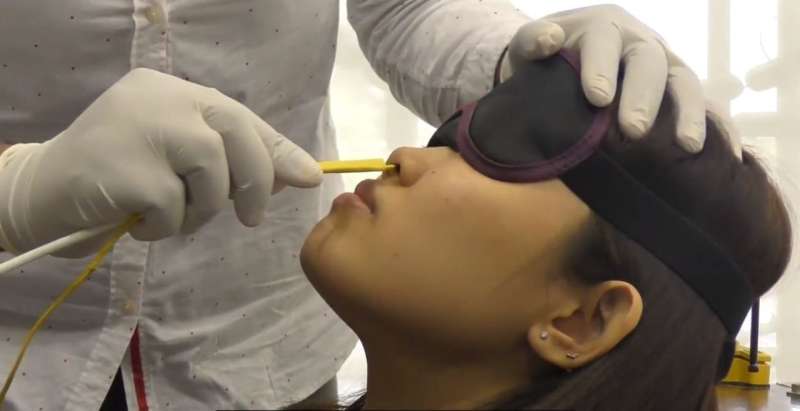October 23, 2018 weblog
Malaysia team is focused on a digital smell future

The very idea of "multisensory" communication is provocative enough, but gets all the more interesting in the context of our digital futures. Can you not only view and hear the scene but smell it too?
Menu-picking based on how dishes smell? Perfume choices based on a phone app that lets you test them out online? A learning app about spices with smell guides online? Game adventure immersion with aromas wafting from your screen?
Back in July a video teased our imaginations when a digital smell technology approach, presented in a video, told the world that amazing things can happen when you stimulate the cells in the nasal passages.
"Electric smell machine"—not the most elegant title for a project, but the video posted in July showed interesting work.
The research team at the Imagineering Institute in Malaysia are behind the device aimed at sending electric charges to the brain via the nose, for triggering sensations of smell. (This is an interesting lab with its focus on digital media and mixed reality research—and at the same time it provides an entrepreneurial incubation space for startups.)
It was explained as an interface that induces "weak electrical pulses" on the small receptors and generates smell sensations. Hanis Cameila Muhar, research engineer, said a pair of silver electrodes carry out the stimulation process; they are inserted inside the nose; this will trigger smell-related perceptions in the brain.
Sharon Kalu Ufere, research engineer, said this indicates there could be an electrical path to generate smell sensations in humans. Sending out digital smells would be useful for industries, she said. Think augmented reality, virtual reality, entertainment, gaming.
This digital smell research team is led by Kasun Karunanayaka.
Vishwam Sankaran in TNW described the team's efforts. "Karunanayaka's team stuck a thin, flexible cable up the noses of 31 volunteers. The cable's tip had a tiny camera and silver electrodes with which the researchers were able to navigate the subjects' nasal passages."
Sankaran's further details: "Karunanayaka and team were also able to bring the electrodes into contact with the sensitive skin cells of the inner nose that lie seven centimeters above and behind the nostrils."
Why the research matters is partly due to its departure from past research attempts in smell research, where these same cells are stimulated by chemical compounds causing them to send a charge to the brain through the olfactory nerve. Long and short, most attempts in the past involved a scent-making chemical mix.
In this case, they used electric currents.
Vishwam Sankaran, TNW: "Most previous demonstrations used chemical cartridges that attached to computers or phones. In those trials, when a command was sent to the respective devices, it simply triggered the release and mixing of substances to produce an odor."
So, is using electrical stimulation directly up your nostrils a breakthrough? Let's be serious; sticking a cable up your nose, so electrodes can make contact with neurons deep in the nasal passages, can this catch on like wildfire?
IEEE Spectrum's Eliza Strickland recognized the situation, in saying their technology's form factor, as she put it, "leaves something to be desired." But they are not inclined to stop exploring possibilities.
But what alternative could they find to sticking up tubes in noses? Strickland said they have "ideas for improvements."
Well, there has been a turn of events since July:
"Karunanayaka's team is collaborating with a Japanese startup called Scentee that he says is developing 'the world's first smartphone gadget that can produce smell sensations,' " said IEEE Spectrum.
The team is reported to be collaborating with Scentee for a smartphone gadget that can produce sensations of smell. Together, they plan on building an app that integrates with other apps to add smells to phone functions. The TNW report said that with Scentee's help, the Karunanayaka's team could find a way to effect aromas without sticking a tube up people's noses.
Strickland's article is worth a read for those curious as to what research paths they are now exploring. One of them: "Maybe the researchers could use a headset that provides a noninvasive form of stimulation to trigger that brain region, thus producing smell sensations without the need for either a rose or a nose-cable."
© 2018 Tech Xplore



















